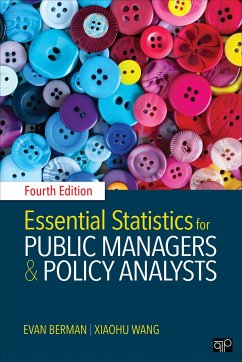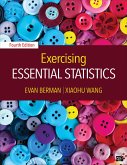- Broschiertes Buch
- Merkliste
- Auf die Merkliste
- Bewerten Bewerten
- Teilen
- Produkt teilen
- Produkterinnerung
- Produkterinnerung
Known for its brevity and student-friendly approach, this book remains one of the most popular introductory books on statistics for public policy and public administration students, using carefully selected examples tailored specifically for them.
Andere Kunden interessierten sich auch für
![Exercising Essential Statistics Exercising Essential Statistics]() Evan M BermanExercising Essential Statistics111,99 €
Evan M BermanExercising Essential Statistics111,99 €![Administrative Law and Politics Administrative Law and Politics]() Christine B HarringtonAdministrative Law and Politics249,99 €
Christine B HarringtonAdministrative Law and Politics249,99 €![The Trusted Leader The Trusted Leader]() The Trusted Leader110,99 €
The Trusted Leader110,99 €![Electronic Engagement: A Guide for Public Sector Managers Electronic Engagement: A Guide for Public Sector Managers]() Peter ChenElectronic Engagement: A Guide for Public Sector Managers26,99 €
Peter ChenElectronic Engagement: A Guide for Public Sector Managers26,99 €![Public Policy Public Policy]() Michael E KraftPublic Policy226,99 €
Michael E KraftPublic Policy226,99 €![Terrorism and Homeland Security Terrorism and Homeland Security]() Gus MartinTerrorism and Homeland Security190,99 €
Gus MartinTerrorism and Homeland Security190,99 €![Exploring Politics Exploring Politics]() Gaspare M GennaExploring Politics163,99 €
Gaspare M GennaExploring Politics163,99 €-
-
-
Known for its brevity and student-friendly approach, this book remains one of the most popular introductory books on statistics for public policy and public administration students, using carefully selected examples tailored specifically for them.
Hinweis: Dieser Artikel kann nur an eine deutsche Lieferadresse ausgeliefert werden.
Hinweis: Dieser Artikel kann nur an eine deutsche Lieferadresse ausgeliefert werden.
Produktdetails
- Produktdetails
- Verlag: Sage Publications
- 4th edition
- Seitenzahl: 368
- Erscheinungstermin: 31. Januar 2017
- Englisch
- Abmessung: 226mm x 152mm x 15mm
- Gewicht: 522g
- ISBN-13: 9781506364315
- ISBN-10: 1506364314
- Artikelnr.: 47150418
- Herstellerkennzeichnung
- Libri GmbH
- Europaallee 1
- 36244 Bad Hersfeld
- gpsr@libri.de
- Verlag: Sage Publications
- 4th edition
- Seitenzahl: 368
- Erscheinungstermin: 31. Januar 2017
- Englisch
- Abmessung: 226mm x 152mm x 15mm
- Gewicht: 522g
- ISBN-13: 9781506364315
- ISBN-10: 1506364314
- Artikelnr.: 47150418
- Herstellerkennzeichnung
- Libri GmbH
- Europaallee 1
- 36244 Bad Hersfeld
- gpsr@libri.de
Evan M. Berman is Professor of Public Management and Director of Internationalization at Victoria University of Wellington, School of Government. Prior, he was the Huey McElveen Distinguished Professor at Louisiana State University. His areas of expertise are human resource management, public performance, local government, and public governance in Asia. He is past Chair of the American Society for Public Administration's Section of Personnel and Labor Relations. He has over 125 publications and 12 books, including People Skills At Work (CRC Press, 2011), Essential Statistics for Public Managers and Policy Analysts, Third Edition (CQ Press, 2012), and a trilogy of books on Public Administration in Asia (2010, 2011, 2013, CRC Press). He has published in all major journals of the discipline, is Senior Editor of Public Performance & Management Review, a Distinguished Fulbright Scholar, past University Chair Professor at National Chengchi University (Taipei, Taiwan), and a former policy analyst with the National Science Foundation.
Tables, Figures, and Boxes
Preface
Acknowledgments
Statistics Roadmap
Section I: Introduction
Chapter 1 Why Statistics for Public Managers and Policy Analysts?
Chapter Objectives
Role of Data in Public Management
Competency and Proficiency
Ethics in Data Analysis and Research
Summary
Key Terms
Section II: Research Methods
Chapter 2 Research Design
Chapter Objectives
Introducing Variables and Their Relationships
Program Evaluation
A Bit More: Extending through Quasi-experimental Design
Summary
Key Terms
Chapter 3 Conceptualization and Measurement
Chapter Objectives
Measurement Levels and Scales
Conceptualization
Operationalization
Index Variables
Measurement Validity
Summary
Key Terms
Chapter 4 Measuring and Managing Performance: Present and Future
Chapter Objectives
Performance Measurement
Managing Performance
Efficiency, Effectiveness, and a Bit More
Peering Into the Future: Forecasting
Summary
Key Terms
Chapter 5 Data Collection
Chapter Objectives
Sources of Data
Sampling
Data Input
Putting It Together
Summary
Key Terms
Section III: Descriptive Statistics
Chapter 6 Central Tendency
Chapter Objectives
The Mean
The Median
The Mode
Summary
Key Terms
Appendix 6.1: Using Grouped Data
Chapter 7 Measures of Dispersion
Chapter Objectives
Frequency Distributions
Standard Deviation
Summary
Key Terms
Appendix 7.1: Boxplots
Chapter 8 Contingency Tables
Chapter Objectives
Contingency Tables
Relationship and Direction
Pivot Tables
Summary
Key Terms
Chapter 9 Getting Results
Chapter Objectives
Analysis of Outputs and Outcomes
Analysis of Efficiency and Effectiveness
Analysis of Equity
Quality-of-Life Analysis
A Bit of Forecasting, Too
Some Cautions in Analysis and Presentation
Summary
Key Terms
Appendix 9.1: Forecasting with Periodic Effects
Section IV: Inferential Statistics
Chapter 10 Introducing Inference: Estimation from Samples
Chapter Objectives
From Sample to Population
Statistical Estimation of Population Parameters
Summary
Key Terms
Chapter 11 Hypothesis Testing with Chi-Square
Chapter Objectives
What Is Chi-Square?
Hypothesis Testing
The Goodness-of-Fit Test
A Nonparametric Alternative
Summary
Key Terms
Appendix 11.1: Rival Hypotheses: Adding a Control Variable
Appendix 11.2: Some Nonparametric Tests for Specific Situations
Chapter 12 The T-Test
Chapter Objectives
T-Tests for Independent Samples
Two T-Test Variations
Nonparametric Alternatives to T-Tests
Summary
Key Terms
Chapter 13 Analysis of Variance (ANOVA)
Chapter Objectives
Analysis of Variance
A Nonparametric Alternative
Summary
Key Terms
Chapter 14 Simple Regression
Chapter Objectives
Simple Regression
Pearson's Correlation Coefficient
Spearman's Rank Correlation Coefficient
Summary
Key Terms
Chapter 15 Multiple Regression
Chapter Objectives
Model Specification
A Working Example
Further Statistics
Use of Nominal Variables
Testing Assumptions
Summary
Key Terms
Section V: Further Statistics
Chapter 16 Logistic and Time Series Regression
Chapter Objectives
The Logistic Model
A Working Example
Time Series in Multiple Regression
Summary
Key Terms
Chapter 17 Survey of Other Techniques
Chapter Objectives
Path Analysis
Statistical Forecasting
Survival Analysis
Factor Analysis
Summary
Key Terms
Appendixes
A: Normal Distribution
B: Chi-Square (c2) Distribution
C: T-Test Distribution
D: Durbin-Watson Distribution
E: F-Test Distribution
Glossary
Index
About the Authors
Preface
Acknowledgments
Statistics Roadmap
Section I: Introduction
Chapter 1 Why Statistics for Public Managers and Policy Analysts?
Chapter Objectives
Role of Data in Public Management
Competency and Proficiency
Ethics in Data Analysis and Research
Summary
Key Terms
Section II: Research Methods
Chapter 2 Research Design
Chapter Objectives
Introducing Variables and Their Relationships
Program Evaluation
A Bit More: Extending through Quasi-experimental Design
Summary
Key Terms
Chapter 3 Conceptualization and Measurement
Chapter Objectives
Measurement Levels and Scales
Conceptualization
Operationalization
Index Variables
Measurement Validity
Summary
Key Terms
Chapter 4 Measuring and Managing Performance: Present and Future
Chapter Objectives
Performance Measurement
Managing Performance
Efficiency, Effectiveness, and a Bit More
Peering Into the Future: Forecasting
Summary
Key Terms
Chapter 5 Data Collection
Chapter Objectives
Sources of Data
Sampling
Data Input
Putting It Together
Summary
Key Terms
Section III: Descriptive Statistics
Chapter 6 Central Tendency
Chapter Objectives
The Mean
The Median
The Mode
Summary
Key Terms
Appendix 6.1: Using Grouped Data
Chapter 7 Measures of Dispersion
Chapter Objectives
Frequency Distributions
Standard Deviation
Summary
Key Terms
Appendix 7.1: Boxplots
Chapter 8 Contingency Tables
Chapter Objectives
Contingency Tables
Relationship and Direction
Pivot Tables
Summary
Key Terms
Chapter 9 Getting Results
Chapter Objectives
Analysis of Outputs and Outcomes
Analysis of Efficiency and Effectiveness
Analysis of Equity
Quality-of-Life Analysis
A Bit of Forecasting, Too
Some Cautions in Analysis and Presentation
Summary
Key Terms
Appendix 9.1: Forecasting with Periodic Effects
Section IV: Inferential Statistics
Chapter 10 Introducing Inference: Estimation from Samples
Chapter Objectives
From Sample to Population
Statistical Estimation of Population Parameters
Summary
Key Terms
Chapter 11 Hypothesis Testing with Chi-Square
Chapter Objectives
What Is Chi-Square?
Hypothesis Testing
The Goodness-of-Fit Test
A Nonparametric Alternative
Summary
Key Terms
Appendix 11.1: Rival Hypotheses: Adding a Control Variable
Appendix 11.2: Some Nonparametric Tests for Specific Situations
Chapter 12 The T-Test
Chapter Objectives
T-Tests for Independent Samples
Two T-Test Variations
Nonparametric Alternatives to T-Tests
Summary
Key Terms
Chapter 13 Analysis of Variance (ANOVA)
Chapter Objectives
Analysis of Variance
A Nonparametric Alternative
Summary
Key Terms
Chapter 14 Simple Regression
Chapter Objectives
Simple Regression
Pearson's Correlation Coefficient
Spearman's Rank Correlation Coefficient
Summary
Key Terms
Chapter 15 Multiple Regression
Chapter Objectives
Model Specification
A Working Example
Further Statistics
Use of Nominal Variables
Testing Assumptions
Summary
Key Terms
Section V: Further Statistics
Chapter 16 Logistic and Time Series Regression
Chapter Objectives
The Logistic Model
A Working Example
Time Series in Multiple Regression
Summary
Key Terms
Chapter 17 Survey of Other Techniques
Chapter Objectives
Path Analysis
Statistical Forecasting
Survival Analysis
Factor Analysis
Summary
Key Terms
Appendixes
A: Normal Distribution
B: Chi-Square (c2) Distribution
C: T-Test Distribution
D: Durbin-Watson Distribution
E: F-Test Distribution
Glossary
Index
About the Authors
Tables, Figures, and Boxes
Preface
Acknowledgments
Statistics Roadmap
Section I: Introduction
Chapter 1 Why Statistics for Public Managers and Policy Analysts?
Chapter Objectives
Role of Data in Public Management
Competency and Proficiency
Ethics in Data Analysis and Research
Summary
Key Terms
Section II: Research Methods
Chapter 2 Research Design
Chapter Objectives
Introducing Variables and Their Relationships
Program Evaluation
A Bit More: Extending through Quasi-experimental Design
Summary
Key Terms
Chapter 3 Conceptualization and Measurement
Chapter Objectives
Measurement Levels and Scales
Conceptualization
Operationalization
Index Variables
Measurement Validity
Summary
Key Terms
Chapter 4 Measuring and Managing Performance: Present and Future
Chapter Objectives
Performance Measurement
Managing Performance
Efficiency, Effectiveness, and a Bit More
Peering Into the Future: Forecasting
Summary
Key Terms
Chapter 5 Data Collection
Chapter Objectives
Sources of Data
Sampling
Data Input
Putting It Together
Summary
Key Terms
Section III: Descriptive Statistics
Chapter 6 Central Tendency
Chapter Objectives
The Mean
The Median
The Mode
Summary
Key Terms
Appendix 6.1: Using Grouped Data
Chapter 7 Measures of Dispersion
Chapter Objectives
Frequency Distributions
Standard Deviation
Summary
Key Terms
Appendix 7.1: Boxplots
Chapter 8 Contingency Tables
Chapter Objectives
Contingency Tables
Relationship and Direction
Pivot Tables
Summary
Key Terms
Chapter 9 Getting Results
Chapter Objectives
Analysis of Outputs and Outcomes
Analysis of Efficiency and Effectiveness
Analysis of Equity
Quality-of-Life Analysis
A Bit of Forecasting, Too
Some Cautions in Analysis and Presentation
Summary
Key Terms
Appendix 9.1: Forecasting with Periodic Effects
Section IV: Inferential Statistics
Chapter 10 Introducing Inference: Estimation from Samples
Chapter Objectives
From Sample to Population
Statistical Estimation of Population Parameters
Summary
Key Terms
Chapter 11 Hypothesis Testing with Chi-Square
Chapter Objectives
What Is Chi-Square?
Hypothesis Testing
The Goodness-of-Fit Test
A Nonparametric Alternative
Summary
Key Terms
Appendix 11.1: Rival Hypotheses: Adding a Control Variable
Appendix 11.2: Some Nonparametric Tests for Specific Situations
Chapter 12 The T-Test
Chapter Objectives
T-Tests for Independent Samples
Two T-Test Variations
Nonparametric Alternatives to T-Tests
Summary
Key Terms
Chapter 13 Analysis of Variance (ANOVA)
Chapter Objectives
Analysis of Variance
A Nonparametric Alternative
Summary
Key Terms
Chapter 14 Simple Regression
Chapter Objectives
Simple Regression
Pearson's Correlation Coefficient
Spearman's Rank Correlation Coefficient
Summary
Key Terms
Chapter 15 Multiple Regression
Chapter Objectives
Model Specification
A Working Example
Further Statistics
Use of Nominal Variables
Testing Assumptions
Summary
Key Terms
Section V: Further Statistics
Chapter 16 Logistic and Time Series Regression
Chapter Objectives
The Logistic Model
A Working Example
Time Series in Multiple Regression
Summary
Key Terms
Chapter 17 Survey of Other Techniques
Chapter Objectives
Path Analysis
Statistical Forecasting
Survival Analysis
Factor Analysis
Summary
Key Terms
Appendixes
A: Normal Distribution
B: Chi-Square (c2) Distribution
C: T-Test Distribution
D: Durbin-Watson Distribution
E: F-Test Distribution
Glossary
Index
About the Authors
Preface
Acknowledgments
Statistics Roadmap
Section I: Introduction
Chapter 1 Why Statistics for Public Managers and Policy Analysts?
Chapter Objectives
Role of Data in Public Management
Competency and Proficiency
Ethics in Data Analysis and Research
Summary
Key Terms
Section II: Research Methods
Chapter 2 Research Design
Chapter Objectives
Introducing Variables and Their Relationships
Program Evaluation
A Bit More: Extending through Quasi-experimental Design
Summary
Key Terms
Chapter 3 Conceptualization and Measurement
Chapter Objectives
Measurement Levels and Scales
Conceptualization
Operationalization
Index Variables
Measurement Validity
Summary
Key Terms
Chapter 4 Measuring and Managing Performance: Present and Future
Chapter Objectives
Performance Measurement
Managing Performance
Efficiency, Effectiveness, and a Bit More
Peering Into the Future: Forecasting
Summary
Key Terms
Chapter 5 Data Collection
Chapter Objectives
Sources of Data
Sampling
Data Input
Putting It Together
Summary
Key Terms
Section III: Descriptive Statistics
Chapter 6 Central Tendency
Chapter Objectives
The Mean
The Median
The Mode
Summary
Key Terms
Appendix 6.1: Using Grouped Data
Chapter 7 Measures of Dispersion
Chapter Objectives
Frequency Distributions
Standard Deviation
Summary
Key Terms
Appendix 7.1: Boxplots
Chapter 8 Contingency Tables
Chapter Objectives
Contingency Tables
Relationship and Direction
Pivot Tables
Summary
Key Terms
Chapter 9 Getting Results
Chapter Objectives
Analysis of Outputs and Outcomes
Analysis of Efficiency and Effectiveness
Analysis of Equity
Quality-of-Life Analysis
A Bit of Forecasting, Too
Some Cautions in Analysis and Presentation
Summary
Key Terms
Appendix 9.1: Forecasting with Periodic Effects
Section IV: Inferential Statistics
Chapter 10 Introducing Inference: Estimation from Samples
Chapter Objectives
From Sample to Population
Statistical Estimation of Population Parameters
Summary
Key Terms
Chapter 11 Hypothesis Testing with Chi-Square
Chapter Objectives
What Is Chi-Square?
Hypothesis Testing
The Goodness-of-Fit Test
A Nonparametric Alternative
Summary
Key Terms
Appendix 11.1: Rival Hypotheses: Adding a Control Variable
Appendix 11.2: Some Nonparametric Tests for Specific Situations
Chapter 12 The T-Test
Chapter Objectives
T-Tests for Independent Samples
Two T-Test Variations
Nonparametric Alternatives to T-Tests
Summary
Key Terms
Chapter 13 Analysis of Variance (ANOVA)
Chapter Objectives
Analysis of Variance
A Nonparametric Alternative
Summary
Key Terms
Chapter 14 Simple Regression
Chapter Objectives
Simple Regression
Pearson's Correlation Coefficient
Spearman's Rank Correlation Coefficient
Summary
Key Terms
Chapter 15 Multiple Regression
Chapter Objectives
Model Specification
A Working Example
Further Statistics
Use of Nominal Variables
Testing Assumptions
Summary
Key Terms
Section V: Further Statistics
Chapter 16 Logistic and Time Series Regression
Chapter Objectives
The Logistic Model
A Working Example
Time Series in Multiple Regression
Summary
Key Terms
Chapter 17 Survey of Other Techniques
Chapter Objectives
Path Analysis
Statistical Forecasting
Survival Analysis
Factor Analysis
Summary
Key Terms
Appendixes
A: Normal Distribution
B: Chi-Square (c2) Distribution
C: T-Test Distribution
D: Durbin-Watson Distribution
E: F-Test Distribution
Glossary
Index
About the Authors








